Class 9 Science Chapter 1 Question Answers - Matter in Our Surroundings
| Table of contents |

|
| Very Short Answer Type Questions |

|
| Short Answer Type Questions |

|
| Long Answer Type Questions |

|
| Value-Based Answer Type Questions |

|
Very Short Answer Type Questions
Q.1. Define matter.
Ans. Anything that occupies space and has mass is called matter.
Q.2. State different states of matter with an example.
Ans. The matter has 3 different states
Q.3. What is diffusion?
Ans. Diffusion is the process where particles of one substance mix with those of another.
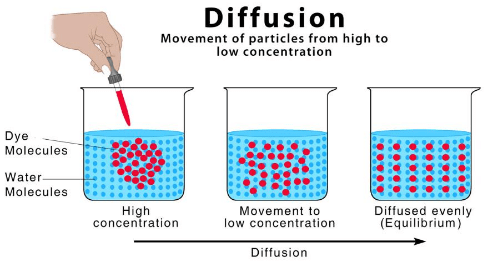 Diffusion
Diffusion
Q.4. What happens to the rate of diffusion if the temperature is increased?
Ans. With increased temperature, the rate of diffusion also increases as the particles gain energy and vibrate more.
Q.5. Name the state of matter that has the tendency to maintain its shape when subjected to outside force.
Ans. A solid maintains its shape when force is applied. Examples include items like a pen, book, or wooden stick.
Q.6. Define melting point.
Ans. The melting point is the temperature at which a solid turns into a liquid under normal atmospheric pressure.
Q.7. Define boiling point.
Ans. The boiling point is the temperature at which a liquid begins to change into gas at normal atmospheric pressure.
Q.8. Define latent heat of vaporization.
Ans. Latent heat of vaporization is the heat energy required to change 1 kg of a liquid to gas at atmospheric pressure at its boiling point.
Q.9. Define latent heat of fusion.
Ans. Latent heat of vaporization is the amount of heat energy needed to convert 1 kg of a liquid into gas at its boiling point, under atmospheric pressure.
Q.10. Define sublimation.
Ans. Sublimation is the process where a solid changes directly into a gas without becoming a liquid. This can also occur in reverse, where a gas turns into a solid without passing through the liquid state.
 SublimationQ.11. What is dry ice?
SublimationQ.11. What is dry ice?
Ans. Solid carbon dioxide is obtained by cooling and applying pressure on carbon dioxide gas. It does not melt, so it is called dry ice.
Q.12. What is humidity?
Ans. Humidity refers to the amount of water vapour present in the air. When air contains a significant amount of water vapour, it is described as humid air.
Q.13. Give two properties of a solid.
Ans.
(i) Solids have fixed shapes and are rigid.
(ii) Solids cannot be compressed.
Q.14. What will happen if the pressure is reduced on solid carbon dioxide (dry ice)?
Ans. If the pressure is reduced on solid carbon dioxide, it will directly change into a gaseous state without melting.
Q.15. Name any three substances that show sublimation.
Ans. Ammonium chloride, camphor, and naphthalene are three substances that undergo sublimation.
Q.16. Sponge is solid, but we can still compress it. Why?
Ans. A sponge is a solid that contains tiny holes, which trap air. When we compress the sponge, the air in these pores is pushed out, allowing the sponge to become smaller in size. This is why we can compress it despite it being a solid.
Q.17. What is normal atmospheric pressure?
Ans. The normal atmospheric pressure at sea level is defined as:
- 1 atmosphere (atm)
- This is equivalent to 101,325 pascals (Pa).
Thus, the standard measure of atmospheric pressure is 1 atm at sea level.
Q.18. What is Kelvin?
Ans. Kelvin is the SI unit of temperature.
- 0°C is equivalent to 273 K.
- To convert from Kelvin to Celsius, subtract 273.
- To convert from Celsius to Kelvin, add 273.
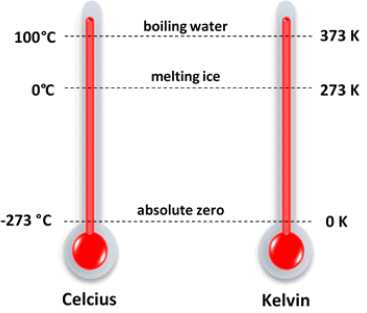 Temperature Scale in Degree and Kelvin
Temperature Scale in Degree and Kelvin
Q.19. Give two examples of diffusion.
Ans. Examples of diffusion:
- Milk drops dissolving in water.
- Perfume sprayed in a room.
Q.20. Give the temperature at which water exists in two different phases/states.
Ans.
(i) At 0°C, water can be in a solid or in liquid state.
(ii) At 100°C, water can be in liquid or in a gaseous state.
Short Answer Type Questions
Q.1. Why do we see water droplets collected on the outer surface of a glass container containing ice?
Ans. The water vapor present in the air comes in contact with the cold outer surface of the container, thereby condensing it to form water droplets.
Q.2. Explain why solids have a fixed shape but liquids and gases do not have a fixed shape.
Ans. Solids maintain a fixed shape because of strong intermolecular forces that hold their particles tightly together. In contrast:
- Liquids have weaker intermolecular forces, allowing their particles to move freely. This enables them to flow and take the shape of their container.
- Gases have even weaker forces, resulting in particles that are far apart and move rapidly. They expand to fill any available space.
Thus, solids are rigid and retain their shape, while liquids and gases are fluid and adaptable to their surroundings.
Q.3. Liquids and gases can be compressed but it is difficult to compress solids. Why?
Ans. Liquids and gases can be compressed, while solids cannot. This is due to the following reasons:
- Intermolecular space: Liquids and gases have space between their molecules, allowing them to be pushed closer together when pressure is applied.
- Solid structure: Solids have tightly packed molecules with little to no space between them, making it difficult to compress.
In summary, the lack of intermolecular space in solids prevents them from being compressed effectively.
Q.4. A balloon, when kept in the sun, bursts after some time. Why?
Ans. The balloon contains air, which heats up when exposed to sunlight. As the temperature rises:
- The air molecules gain energy.
- They vibrate faster and expand.
- This expansion exerts increased pressure on the walls of the balloon.
Eventually, the pressure becomes too much, causing the balloon to burst.
Q.5. Why do people perspire a lot on a hot, humid day?
Ans. On a hot, humid day, people perspire more because:
- The body sweats to cool down through evaporation.
- In humid conditions, the air is already saturated with moisture.
- This prevents sweat from evaporating efficiently, leading to visible perspiration.
Q.6. Distinguish between evaporation and boiling.
Ans.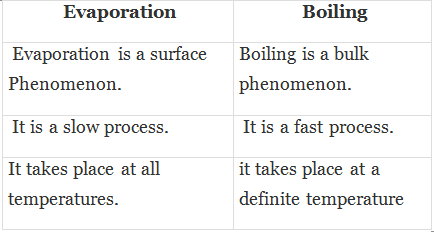
Q.7. Why is it advisable to use a pressure cooker at higher altitudes?
Ans. At higher altitudes, the atmospheric pressure is low, and the water boils very fast and evaporates at a faster rate therefore, the pressure is required to increase the cooking process, and this is done by using a pressure cooker, which increases the pressure inside the container and cooks food faster.
Q.8. What are fluids?
Ans. Fluids are substances that can flow and take the shape of their container. They include:
- Liquids - Have a definite volume but no fixed shape.
- Gases - Have neither a fixed shape nor a fixed volume.
This ability to flow is due to the weaker intermolecular forces present in these states of matter.
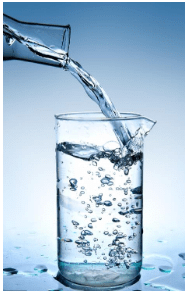
Q.9. One kg cotton and one kg sand, which is more denser? Why?
Ans. One kg of sand is denser than 1 kg of cotton because
Density = Mass/Volume
The volume required by cotton is more than the sand, and density and volume are inversely proportional.
Q.10. Why is water liquid at room temperature?
Ans. At room temperature, water remains a liquid because:
- The molecules of water are held together by intermolecular forces.
- Room temperature does not provide enough energy for these molecules to overcome their attraction.
- As a result, they stay in the liquid phase.
Q.11. State the differences between solid, liquid and gas.
Ans.
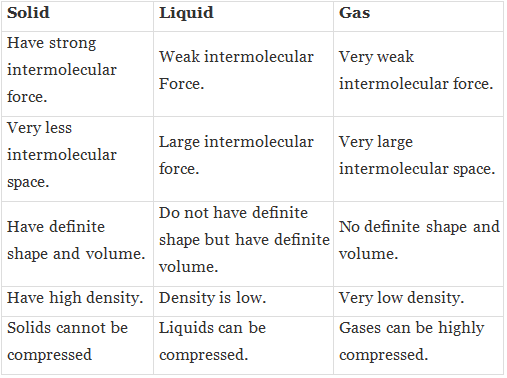
Q.12. Cotton is solid but it floats on water. Why?
Ans. Cotton has a large number of pores in which air is trapped. Reducing its density and increasing its volume. Therefore, cotton floats on water. But when these pores get filled with water, it starts sinking.
Q.13. Why are solids generally denser than liquids and gases?
Ans. The density of a substance is calculated using the formula: mass/volume. Here’s why solids are generally denser than liquids and gases:
- Solids have molecules that are tightly packed together.
- This packing results in a large mass being concentrated in a small volume.
- In contrast, liquids and gases have more intermolecular space.
- This means their mass is not concentrated in a small volume, leading to lower density.
Therefore, solids typically have a higher density than both liquids and gases.
Q.14. On a hot sunny day, why do people sprinkle water on the roof or open ground?
Ans. On hot sunny days, people sprinkle water on roofs or open ground for several reasons:
- The surface absorbs a lot of heat, making it very hot.
- When water is sprinkled, it absorbs heat from the surface due to its latent heat of vaporisation.
- This process allows the hot surface to cool down effectively.
Q.15. On a hot sunny day, why do we feel pleasant sitting under a tree?
Ans. A tree provides a pleasant experience on a hot sunny day due to the following reasons:
- The numerous leaves of the tree engage in a process called transpiration.
- During transpiration, water is released from tiny pores in the leaves known as stomata.
- This water evaporates, creating a cooling effect in the surrounding air.
As a result, sitting under a tree helps us feel more comfortable and refreshed on warm days.
Q.16. The temperature at which liquids change into vapors is very high, for example, if water evaporates at 100°C, then how is water to evaporate at room temperature or at other temperatures?
Ans. The molecules of water at the surface of a liquid can evaporate even at room temperature. This occurs because:
- Surface molecules gain energy from the surroundings.
- These molecules achieve higher kinetic energy, allowing them to overcome the forces holding them in the liquid state.
- This process, where liquid changes to vapour below its boiling point, is known as evaporation.
Examples of evaporation in everyday life include:
- Water left uncovered slowly turns into vapour.
- Wet clothes dry as water evaporates from their surface.
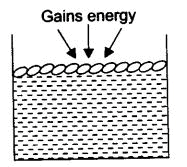
Q.17. Name the factors that affect evaporation.
Ans. The rate of evaporation is influenced by several factors:
- Surface area: A larger surface area increases the rate of evaporation.
- Temperature: Higher temperatures provide more energy, leading to faster evaporation.
- Humidity: Lower humidity levels allow for more evaporation, as the air can hold less water vapour.
- Wind speed: Increased wind speed helps remove water vapour from the surface, enhancing evaporation.
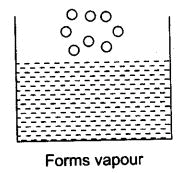
Q.18. The melting point of ice is 273.16 K. What does this mean? Explain in detail.
Ans. The melting point of ice is 273.15 K, which is equivalent to 0°C. This temperature indicates that:
- At 0°C, ice exists in a solid state.
- The molecules in ice are tightly packed and held together by attractive forces.
- When heat is applied, the ice absorbs this energy, but the temperature remains constant until all ice has melted.
- This absorbed heat is used to overcome the attractive forces between the molecules, allowing them to move more freely.
- Once these forces are overcome, the ice transitions to a liquid state at the same temperature of 273 K.
The process of melting is known as fusion, and during this phase change, the temperature does not increase despite the continuous heat supply.
Q.19. How is the high compressibility property of gas useful to us?
Ans. The high compressibility of gases is beneficial in several ways:
- It allows large volumes of gas to be stored in small cylinders, making transportation easier.
- Compressed gases, like liquefied petroleum gas (LPG) and compressed natural gas (CNG), are used as fuels.
- This property enables efficient use of space in various applications, such as in medical oxygen cylinders.
Q.20. With the help of an example, explain how diffusion of gases in water is essential.
Ans. The diffusion of gases in water is crucial for aquatic life. Here’s how:
- Oxygen from the atmosphere dissolves in water, allowing aquatic animals to breathe.
- Carbon dioxide also dissolves in water, which is essential for plants during photosynthesis.
- These processes support the survival of both aquatic animals and plants.
Long Answer Type Questions
Q.1. Pressure and temperature determine the state of a substance. Explain this in detail.
Ans.
(a) Any matter i.e., solid, liquid, or gas, that experiences an increase in temperature and then changes its state.
Take ice cubes in a beaker or heat them slowly. The temperature increases, and the ice melts to form a liquid. Heat this liquid further it will become steam.
(b) On lowering the temperature of any matter, show a change in their state.
Take the steam that is coming out of boiling water and allow it to cool down; it condenses to form water and on further cooling of this water, we get ice.
(c) On applying pressure and reducing temperature, we can liquefy gases or change them into solids. Example: Take carbon dioxide gas, reduce its temperature, and apply a lot of pressure on it so that it changes into solid carbon dioxide, called dry ice, which is used as refrigerant for cooling. If the pressure on it is decreased it directly changes into gas.
In LPG cylinders, the petroleum gas is cooled and, with a lot of pressure, changes it into the liquid state.
While using this LPG, we release the pressure exerted on it and hence, it comes out in the form of gas.
Q.2. Explain, giving examples, the various factors on which the rate of evaporation depends.
Ans. The rate of evaporation depends on the following factors:
- Surface area: If the surface area is increased, the rate of evaporation also increases.
(a) To dry the clothes, we spread them to dry faster.
(b) Tea in a saucer cools faster than in a cup. - Temperature: If the temperature is increased, the rate of evaporation also increases. Due to an increase in temperature, the particles gain more kinetic energy and change their phase from liquid to gaseous. Water will evaporate faster in the sun than in the shade.
- Humidity: It is the amount of water vapor present in the air. The air can hold a definite amount of water vapor at a given temperature. If the amount of water vapor is high in the air, then the rate of evaporation decreases. On hot and humid days, desert coolers are not effective as the air cannot hold any more moisture to get the cooling effect.
- Wind speed: With the increase in wind speed, the rate of evaporation increases. The particles of water vapor move away with the wind, decreasing the amount of water vapor in the surroundings.
Value-Based Answer Type Questions
Q.1. Adil parked his bicycle on a sunny day in a parking stand on his school campus. When the school got over, Adil saw his burst cycle type. Thereafter, he kept less air in his cycle types and did not inflate them fully.
(a) Why did the tyre burst?
(b) Why is air compressible?
(c) What value of Adil is reflected in the above act?
Ans.
(a) The tyre burst because the air inside the tyre got heated and therefore exerted pressure on the walls of the tyre.
(b) Air is compressible because it has large intermolecular space.
(c) Adil showed the value of intelligence, awareness and self-responsibility.
Q.2. Akshay’s friend visited his house in Mumbai and he was surprised to see air conditioners installed in all of his rooms. His friend advised Akshay to use water coolers and save electricity. On this, Akshay told him that the water-cooler is not at all effective in coastal areas.
(a) Why are water-coolers not effective in coastal areas?
(b) What are the other two factors on which evaporation of water
depends?
(c) What value of Akshay’s friend is seen in this act?
Ans.
(a) Water coolers are not effective in coastal areas due to the high rate of humidity.
(b) The other two factors on which evaporation of water depends are temperature and surface area.
(c) Akshay’s friend showed the value of concerned citizens, morally responsible and friendly in nature.
Q.3. Sita lived in a village and could not afford a refrigerator in her house. She knew how to keep water cold and preserve all perishable items in her house. She kept an ivet cloth surrounding the earthen pot to keep water cool. She also kept vegetables fresh by keeping them in wet gunny bags and sprinkled water over them in a timely manner.
(a) Why did Sita keep wet cloth surrounding the earthen pot?
(b) Suggest one more method of keeping the house cool in summer.
(c) What value of Sita is reflected in the above case?
Ans.
(a) The wet cloth gave a cooling effect to the pot, as the water in the cloth evaporated and evaporation caused a cooling effect.
(b) By sprinkling some water on the lawn/veranda of the house can keep the house cool.
(c) Sita showed the value of responsible behavior.
Q.4. Shreya commutes in a CNG-fitted van to school every day along with many other students. She told the van driver to get the CNG connection certified and timely check it for any leakage or loose connection of pipes. She told the driver to be more careful during summer.
(a) What is CNG?
(b) Why should one be more careful with CNG cylinders during summer?
(c) What value of Shreya is seen in the above act?
Ans.
(a) CNG is Compressed Natural Gas used as fuel.
(b) During summers, the CNG connections and cylinder need to be checked because the gas expands due to heat and if there is any leakage, then it would cause a fire in the vehicle.
(c) Shreya showed the value of being a concerned citizen and morally responsible behavior.
|
84 videos|478 docs|60 tests
|
FAQs on Class 9 Science Chapter 1 Question Answers - Matter in Our Surroundings
| 1. What are the different states of matter? |  |
| 2. How does matter change from one state to another? |  |
| 3. What is the difference between physical and chemical changes in matter? |  |
| 4. How does temperature affect the state of matter? |  |
| 5. Why is it important to study matter in our surroundings? |  |
















